2010 SKODA OCTAVIA TOUR seats
[x] Cancel search: seatsPage 100 of 199
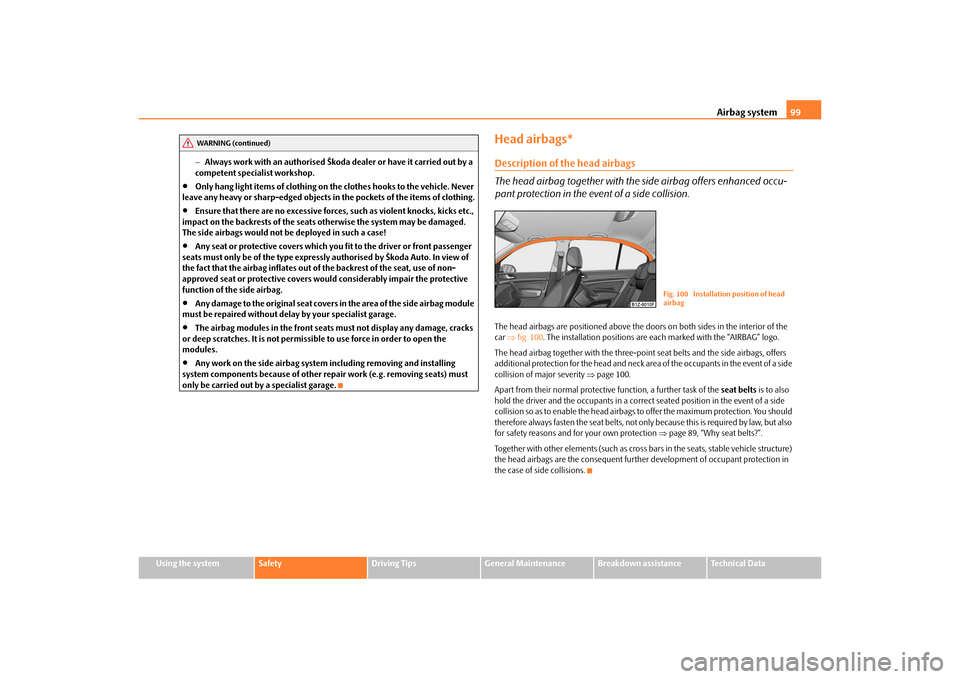
Airbag system99
Using the system
Safety
Driving Tips
General Maintenance
Breakdown assistance
Technical Data
Always work with an authorised Škoda dealer or have it carried out by a
competent specialist workshop.
Only hang light items of clothing on the clothes hooks to the vehicle. Never
leave any heavy or sharp-edged objects in the pockets of the items of clothing.
Ensure that there are no excessive forc es, such as violent knocks, kicks etc.,
impact on the backrests of the seats otherwise the system may be damaged.
The side airbags would not be deployed in such a case!
Any seat or protective covers which you fit to the driver or front passenger
seats must only be of the type expressly authorised by Škoda Auto. In view of
the fact that the airbag inflates out of the backrest of the seat, use of non-
approved seat or protective covers would considerably impair the protective
function of the side airbag.
Any damage to the original seat covers in the area of the side airbag module
must be repaired without dela y by your specialist garage.
The airbag modules in the front seats must not display any damage, cracks
or deep scratches. It is not permissible to use force in order to open the
modules.
Any work on the side airbag system including removing and installing
system components because of other repair work (e.g. removing seats) must
only be carried out by a specialist garage.
Head airbags*Description of the head airbags
The head airbag together with the side airbag offers enhanced occu-
pant protection in the event of a side collision.The head airbags are positioned above the door s on both sides in the interior of the
car fig. 100 . The installation positions are each marked with the “AIRBAG” logo.
The head airbag together with the three-poin t seat belts and the side airbags, offers
additional protection for the head and neck ar ea of the occupants in the event of a side
collision of major severity page 100.
Apart from their normal protective function, a further task of the seat belts is to also
hold the driver and the occupants in a correct seated position in the event of a side
collision so as to enable the head airbags to offer the maximum protection. You should
therefore always fasten the seat belts, not only because this is required by law, but also
for safety reasons and for your own protection page 89, “Why seat belts?”.
Together with other elements (such as cross bars in the seats, stable vehicle structure)
the head airbags are the consequent further development of occupant protection in
the case of side collisions.
WARNING (continued)
Fig. 100 Installation position of head
airbag
s2bs.2.book Page 99 Monday, September 27, 2010 9:53 AM
Page 101 of 199
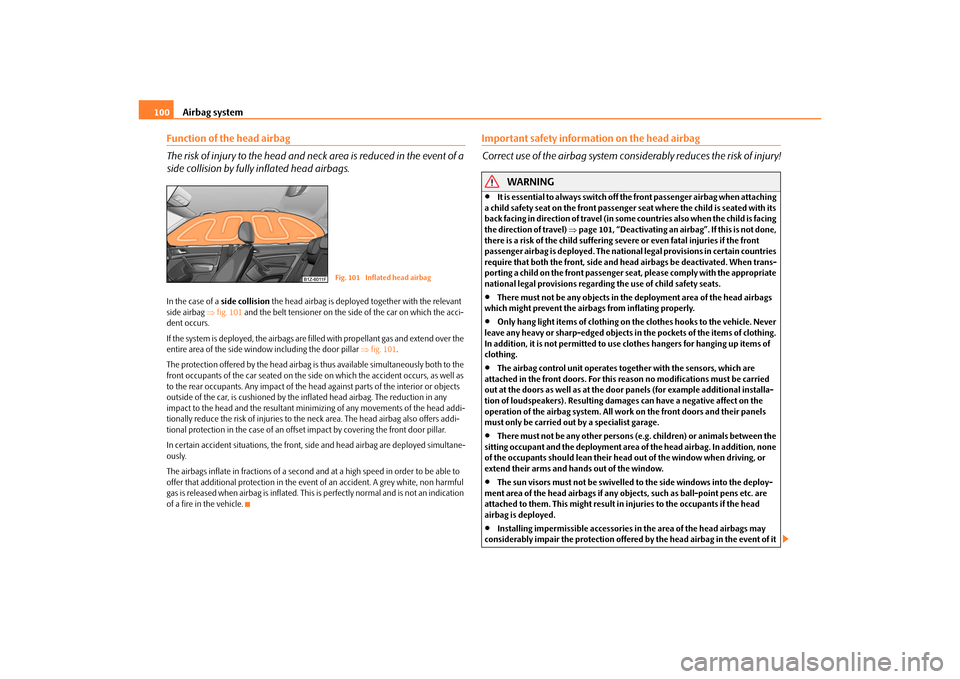
Airbag system
100
Function of the head airbag
The risk of injury to the head and neck area is reduced in the event of a
side collision by fully inflated head airbags.In the case of a side collision the head airbag is deployed together with the relevant
side airbag fig. 101 and the belt tensioner on the side of the car on which the acci-
dent occurs.
If the system is deployed, the airbags are filled with propellant gas and extend over the
entire area of the side wind ow including the door pillar fig. 101 .
The protection offered by the head airbag is thus available simultaneously both to the
front occupants of the car seated on the side on which the accident occurs, as well as
to the rear occupants. Any impact of the head against parts of the interior or objects
outside of the car, is cushioned by the in flated head airbag. The reduction in any
impact to the head and the resultant minimi zing of any movements of the head addi-
tionally reduce the risk of injuries to the neck area. The head airbag also offers addi-
tional protection in the case of an offset impact by covering the front door pillar.
In certain accident situations , the front, side and head airbag are deployed simultane-
ously.
The airbags inflate in fractions of a second an d at a high speed in order to be able to
offer that additional protection in the even t of an accident. A grey white, non harmful
gas is released when airbag is inflated. This is perfectly normal and is not an indication
of a fire in the vehicle.
Important safety information on the head airbag
Correct use of the airbag system cons iderably reduces the risk of injury!
WARNING
It is essential to always switch off the front passenger airbag when attaching
a child safety seat on the front passenger seat where the child is seated with its
back facing in direction of travel (in some countries also when the child is facing
the direction of travel) page 101, “Deactivating an airbag”. If this is not done,
there is a risk of the child suffering seve re or even fatal injuries if the front
passenger airbag is deployed. The national legal provisions in certain countries
require that both the front, side and head airbags be deactivated. When trans-
porting a child on the front passenger seat, please comply with the appropriate
national legal provisions regardin g the use of child safety seats.
There must not be any objects in the deployment area of the head airbags
which might prevent the airbags from inflating properly.
Only hang light items of clothing on the clothes hooks to the vehicle. Never
leave any heavy or sharp-edged objects in the pockets of the items of clothing.
In addition, it is not permitted to use clothes hangers for hanging up items of
clothing.
The airbag control unit operates to gether with the sensors, which are
attached in the front doors. For this reason no modifications must be carried
out at the doors as well as at the door panels (for example additional installa-
tion of loudspeakers). Resulting damage s can have a negative affect on the
operation of the airbag system. All work on the front doors and their panels
must only be carried out by a specialist garage.
There must not be any other persons (e.g. children) or animals between the
sitting occupant and the deployment area of the head airbag. In addition, none
of the occupants should lean their head out of the window when driving, or
extend their arms and hands out of the window.
The sun visors must not be swivelled to the side windows into the deploy-
ment area of the head airbags if any objects, such as ball-point pens etc. are
attached to them. This might result in injuries to the occupants if the head
airbag is deployed.
Installing impermissible accessories in the area of the head airbags may
considerably impair the protection offered by the head airbag in the event of it
Fig. 101 Inflated head airbag
s2bs.2.book Page 100 Monday, September 27, 2010 9:53 AM
Page 102 of 199
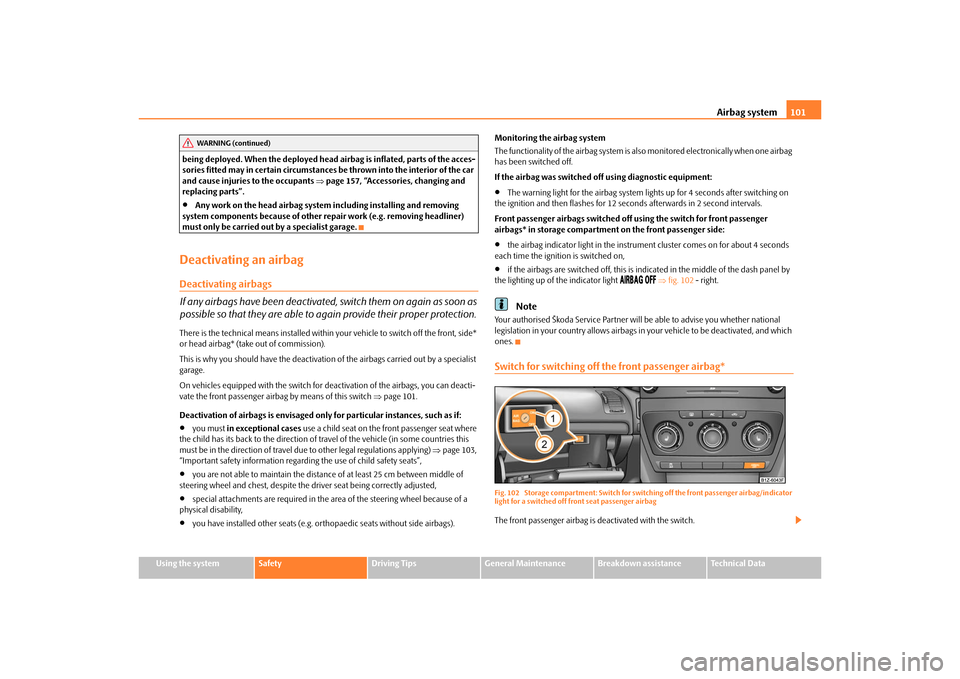
Airbag system101
Using the system
Safety
Driving Tips
General Maintenance
Breakdown assistance
Technical Data
being deployed. When the deployed head airbag is inflated, parts of the acces-
sories fitted may in certain circumstances be thrown into the interior of the car
and cause injuries to the occupants
page 157, “Accessories, changing and
replacing parts”.
Any work on the head airbag system including installing and removing
system components because of other repair work (e.g. removing headliner)
must only be carried out by a specialist garage.
Deactivating an airbagDeactivating airbags
If any airbags have been deactivated, switch them on again as soon as
possible so that they are able to again provide their proper protection.There is the technical means installed within your vehicle to switch off the front, side*
or head airbag* (take out of commission).
This is why you should have the deactivation of the airbags carried out by a specialist
garage.
On vehicles equipped with the switch for de activation of the airbags, you can deacti-
vate the front passenger airbag by means of this switch page 101.
Deactivation of airbags is envisaged only for particular instances, such as if:
you must in exceptional cases use a child seat on the front passenger seat where
the child has its back to the direction of tr avel of the vehicle (in some countries this
must be in the direction of travel due to other legal regulations applying) page 103,
“Important safety information regarding the use of child safety seats”,
you are not able to maintain the distan ce of at least 25 cm between middle of
steering wheel and chest, despite the driver seat being correctly adjusted,
special attachments are required in the ar ea of the steering wheel because of a
physical disability,
you have installed other seats (e.g. orthopaedic seats without side airbags). Monitoring the airbag system
The functionality of the airbag system is al
so monitored electronically when one airbag
has been switched off.
If the airbag was switched off using diagnostic equipment:
The warning light for the airbag system li ghts up for 4 seconds after switching on
the ignition and then flashes for 12 seconds afterwards in 2 second intervals.
Front passenger airbags switched off using the switch for front passenger
airbags* in storage compartmen t on the front passenger side:
the airbag indicator light in the instrume nt cluster comes on for about 4 seconds
each time the igniti on is switched on,
if the airbags are switched off, this is in dicated in the middle of the dash panel by
the lighting up of the indicator light
fig. 102 - right.
Note
Your authorised Škoda Service Partner will be able to advise you whether national
legislation in your country allows airbags in your vehicle to be deactivated, and which
ones.Switch for switching off the front passenger airbag*Fig. 102 Storage compartment: Switch for swit ching off the front passenger airbag/indicator
light for a switched off front seat passenger airbagThe front passenger airbag is deactivated with the switch.
WARNING (continued)
s2bs.2.book Page 101 Monday, September 27, 2010 9:53 AM
Page 104 of 199
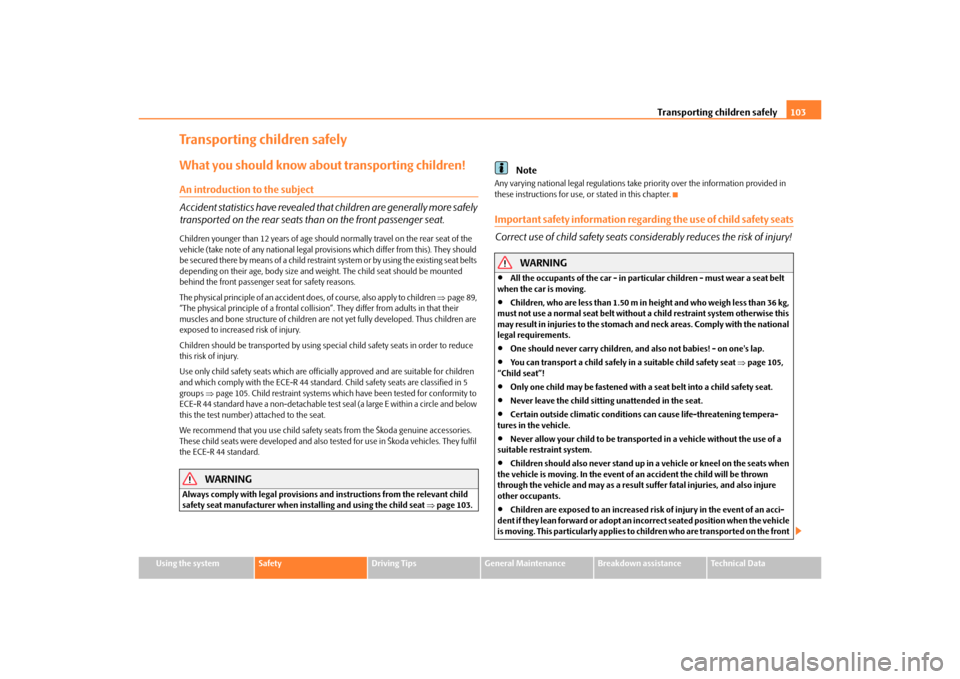
Transporting children safely103
Using the system
Safety
Driving Tips
General Maintenance
Breakdown assistance
Technical Data
Transporting children safelyWhat you should know about transporting children!An introduction to the subject
Accident statistics have revealed that children are generally more safely
transported on the rear seats than on the front passenger seat.Children younger than 12 years of age should normally travel on the rear seat of the
vehicle (take note of any national legal provis ions which differ from this). They should
be secured there by means of a child restraint system or by using the existing seat belts
depending on their age, body size and we ight. The child seat should be mounted
behind the front passenger seat for safety reasons.
The physical principle of an accident does, of course, also apply to children page 89,
“The physical principle of a frontal collision ”. They differ from adults in that their
muscles and bone structure of children are not yet fully developed. Thus children are
exposed to increased risk of injury.
Children should be transporte d by using special child safety seats in order to reduce
this risk of injury.
Use only child safety seats which are officia lly approved and are suitable for children
and which comply with the ECE-R 44 standard. Child safety seats are classified in 5
groups page 105. Child restraint systems which have been tested for conformity to
ECE-R 44 standard have a non-detachable test seal (a large E within a circle and below
this the test number) attached to the seat.
We recommend that you use child safety seats from the Škoda genuine accessories.
These child seats were developed and also tested for use in Škoda vehicles. They fulfil
the ECE-R 44 standard.
WARNING
Always comply with legal provisions and instructions from the relevant child
safety seat manufacturer when inst alling and using the child seat page 103.
Note
Any varying national legal regulations take priority over the information provided in
these instructions for use, or stated in this chapter.Important safety information regarding the use of child safety seats
Correct use of child safety seats cons iderably reduces the risk of injury!
WARNING
All the occupants of the car - in particular children - must wear a seat belt
when the car is moving.
Children, who are less than 1.50 m in height and who weigh less than 36 kg,
must not use a normal seat belt without a child restraint system otherwise this
may result in injuries to the stomach and neck areas. Comply with the national
legal requirements.
One should never carry children, and also not babies! - on one's lap.
You can transport a child safely in a suitable child safety seat page 105,
“Child seat”!
Only one child may be fastened with a seat belt into a child safety seat.
Never leave the child sitting unattended in the seat.
Certain outside climatic conditions can cause life-threatening tempera-
tures in the vehicle.
Never allow your child to be transported in a vehicle without the use of a
suitable restraint system.
Children should also never stand up in a vehicle or kneel on the seats when
the vehicle is moving. In the event of an accident the child will be thrown
through the vehicle and may as a result suffer fatal injuries, and also injure
other occupants.
Children are exposed to an increased risk of injury in the event of an acci-
dent if they lean forward or adopt an in correct seated position when the vehicle
is moving. This particularly applies to children who are transported on the front
s2bs.2.book Page 103 Monday, September 27, 2010 9:53 AM
Page 105 of 199
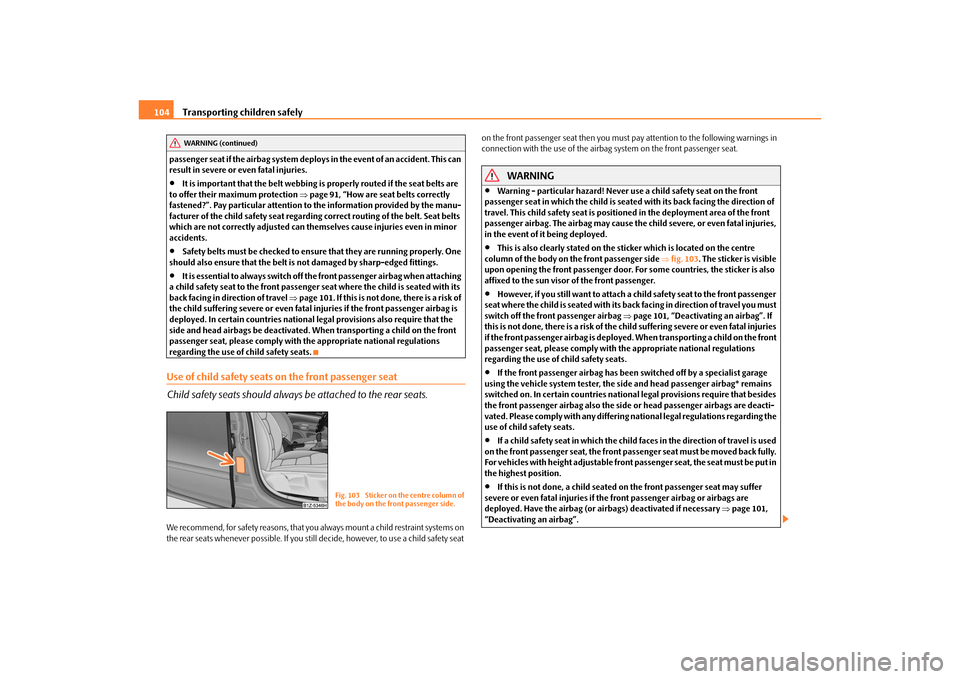
Transporting children safely
104
passenger seat if the airbag system deploy s in the event of an accident. This can
result in severe or even fatal injuries.
It is important that the belt webbing is properly routed if the seat belts are
to offer their maximum protection page 91, “How are seat belts correctly
fastened?”. Pay particular attention to the information provided by the manu-
facturer of the child safety seat regarding correct routing of the belt. Seat belts
which are not correctly adjusted can themselves cause injuries even in minor
accidents.
Safety belts must be checked to ensure that they are running properly. One
should also ensure that the belt is not damaged by sharp-edged fittings.
It is essential to always switch off th e front passenger airbag when attaching
a child safety seat to the front passenger seat where the child is seated with its
back facing in direction of travel page 101. If this is not done, there is a risk of
the child suffering severe or even fatal in juries if the front passenger airbag is
deployed. In certain countries national legal provisions also require that the
side and head airbags be deactivated. When transporting a child on the front
passenger seat, please comply with the appropriate national regulations
regarding the use of child safety seats.
Use of child safety seats on the front passenger seat
Child safety seats should always be attached to the rear seats.We recommend, for safety reasons, that you always mount a child restraint systems on
the rear seats whenever possible. If you still decide, however, to use a child safety seat on the front passenger seat then you must pay attention to the following warnings in
connection with the use of the airbag
system on the front passenger seat.
WARNING
Warning - particular hazard! Never use a child safety seat on the front
passenger seat in which the child is seated with its back facing the direction of
travel. This child safety seat is positioned in the deployment area of the front
passenger airbag. The airbag may cause th e child severe, or even fatal injuries,
in the event of it being deployed.
This is also clearly stated on the sticker which is located on the centre
column of the body on the front passenger side fig. 103 . The sticker is visible
upon opening the front pass enger door. For some countri es, the sticker is also
affixed to the sun visor of the front passenger.
However, if you still want to attach a child safety seat to the front passenger
seat where the child is seated with its back facing in direction of travel you must
switch off the front passenger airbag page 101, “Deactivating an airbag”. If
this is not done, there is a risk of the ch ild suffering severe or even fatal injuries
if the front passenger airbag is deployed. When transporting a child on the front
passenger seat, please comply with the appropriate national regulations
regarding the use of child safety seats.
If the front passenger airbag has been switched off by a specialist garage
using the vehicle system te ster, the side and head passenger airbag* remains
switched on. In certain countries national legal provisions require that besides
the front passenger airbag also the side or head passenger airbags are deacti-
vated. Please comply with any differing national legal regulations regarding the
use of child safety seats.
If a child safety seat in which the child faces in the direction of travel is used
on the front passenger seat, the front pass enger seat must be moved back fully.
For vehicles with height adjustable front passenger seat, the seat must be put in
the highest position.
If this is not done, a child seated on the front passenger seat may suffer
severe or even fatal injuries if the front passenger airbag or airbags are
deployed. Have the airbag (or airbags) deactivated if necessary page 101,
“Deactivating an airbag”.
WARNING (continued)
Fig. 103 Sticker on the centre column of
the body on the front passenger side.
s2bs.2.book Page 104 Monday, September 27, 2010 9:53 AM
Page 106 of 199
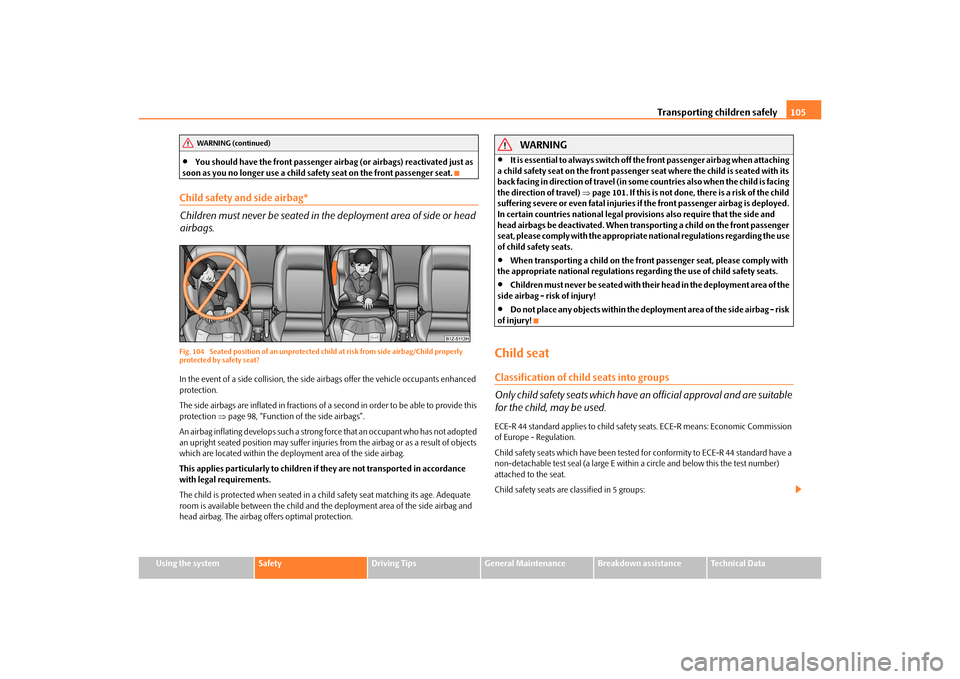
Transporting children safely105
Using the system
Safety
Driving Tips
General Maintenance
Breakdown assistance
Technical Data
You should have the front passenger airbag (or airbags) reactivated just as
soon as you no longer use a child safe ty seat on the front passenger seat.
Child safety and side airbag*
Children must never be seated in the deployment area of side or head
airbags.Fig. 104 Seated position of an unprotected ch ild at risk from side airbag/Child properly
protected by safety seat?In the event of a side collision, the side ai rbags offer the vehicle occupants enhanced
protection.
The side airbags are inflated in fractions of a second in order to be able to provide this
protection page 98, “Function of the side airbags”.
An airbag inflating develops such a strong force that an occupant who has not adopted
an upright seated position may suffer injuries from the airbag or as a result of objects
which are located within the deployment area of the side airbag.
This applies particularly to children if they are not transported in accordance
with legal requirements.
The child is protected when seated in a chil d safety seat matching its age. Adequate
room is available between the child and the deployment area of the side airbag and
head airbag. The airbag offers optimal protection.
WARNING
It is essential to always switch off th e front passenger airbag when attaching
a child safety seat on the front passenger seat where the child is seated with its
back facing in direction of travel (in some countries also when the child is facing
the direction of travel) page 101. If this is not done, there is a risk of the child
suffering severe or even fatal injuries if the front passenger airbag is deployed.
In certain countries national legal provisions also require that the side and
head airbags be deactivated. When transporting a child on the front passenger
seat, please comply with the appropriat e national regulations regarding the use
of child safety seats.
When transporting a child on the front passenger seat, please comply with
the appropriate national regulations r egarding the use of child safety seats.
Children must never be seated with thei r head in the deployment area of the
side airbag - risk of injury!
Do not place any objects within the deployment area of the side airbag - risk
of injury!
Child seatClassification of child seats into groups
Only child safety seats which have an official approval and are suitable
for the child, may be used.ECE-R 44 standard applies to child safety seats. ECE-R means: Economic Commission
of Europe - Regulation.
Child safety seats which have been tested for conformity to ECE-R 44 standard have a
non-detachable test seal (a large E within a circle and below this the test number)
attached to the seat.
Child safety seats are classified in 5 groups:
WARNING (continued)
s2bs.2.book Page 105 Monday, September 27, 2010 9:53 AM
Page 107 of 199
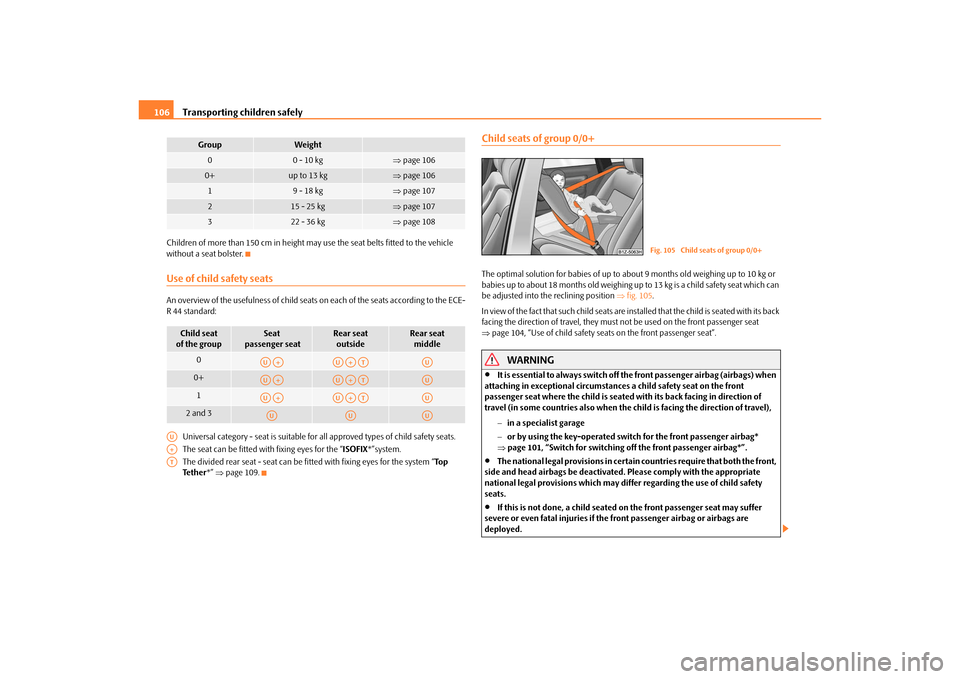
Transporting children safely
106
Children of more than 150 cm in height may use the seat belts fitted to the vehicle
without a seat bolster.Use of child safety seatsAn overview of the usefulness of child seats on each of the seats according to the ECE-
R44 standard:
Universal category - seat is suitable for all approved types of child safety seats.
The seat can be fitted with fixing eyes for the “ ISOFIX*”system.
The divided rear seat - seat can be fitt ed with fixing eyes for the system “To p
Te t h e r *” page 109.
Child seats of group 0/0+The optimal solution for babies of up to about 9 months old weighing up to 10 kg or
babies up to about 18 months old weighing up to 13 kg is a child safety seat which can
be adjusted into the reclining position fig. 105 .
In view of the fact that such child seats are installed that the child is seated with its back
facing the direction of travel, they must not be used on the front passenger seat
page 104, “Use of child safety seats on the front passenger seat”.
WARNING
It is essential to always switch off th e front passenger airbag (airbags) when
attaching in exceptional circumstances a child safety seat on the front
passenger seat where the child is seated with its back facing in direction of
travel (in some countries also when the child is facing the direction of travel),
in a specialist garage
or by using the key-operated swit ch for the front passenger airbag*
page 101, “Switch for switching off the front passenger airbag*”.
The national legal provisions in certain countries require that both the front,
side and head airbags be deactivated. Please comply with the appropriate
national legal provisions which may diff er regarding the use of child safety
seats.
If this is not done, a child seated on the front passenger seat may suffer
severe or even fatal injuries if the front passenger airbag or airbags are
deployed.
Group
Weight
0
0 - 10 kg
page 106
0+
up to 13 kg
page 106
1
9 - 18 kg
page 107
2
15 - 25 kg
page 107
3
22 - 36 kg
page 108
Child seat
of the group
Seat
passenger seat
Rear seat outside
Rear seat middle
0
0+
1
2 and 3
AUA+
AUA+AT
AU
AUA+
AUA+AT
AU
AUA+
AUA+AT
AU
AU
AU
AU
AUA+AT
Fig. 105 Child seats of group 0/0+
s2bs.2.book Page 106 Monday, September 27, 2010 9:53 AM
Page 108 of 199
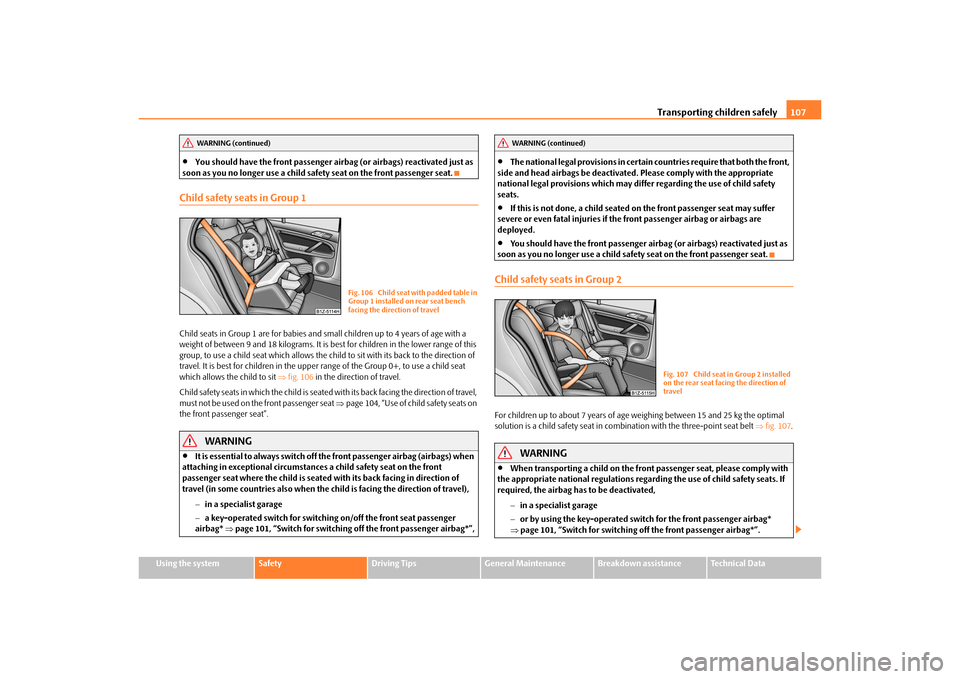
Transporting children safely107
Using the system
Safety
Driving Tips
General Maintenance
Breakdown assistance
Technical Data
You should have the front passenger airbag (or airbags) reactivated just as
soon as you no longer use a child safe ty seat on the front passenger seat.
Child safety seats in Group 1Child seats in Group 1 are for babies and small children up to 4 years of age with a
weight of between 9 and 18 kilograms. It is best for children in the lower range of this
group, to use a child seat which allows the ch ild to sit with its back to the direction of
travel. It is best for children in the uppe r range of the Group 0+, to use a child seat
which allows the child to sit fig. 106 in the direction of travel.
Child safety seats in which the child is seated with its back facing the direction of travel,
must not be used on the front passenger seat page 104, “Use of child safety seats on
the front passenger seat”.
WARNING
It is essential to always switch off th e front passenger airbag (airbags) when
attaching in exceptional circumstances a child safety seat on the front
passenger seat where the child is seated with its back facing in direction of
travel (in some countries also when the child is facing the direction of travel),
in a specialist garage
a key-operated switch for switching on/off the front seat passenger
airbag* page 101, “Switch for switching of f the front passenger airbag*”,
The national legal provisions in certain countries require that both the front,
side and head airbags be deactivated. Please comply with the appropriate
national legal provisions which may diff er regarding the use of child safety
seats.
If this is not done, a child seated on the front passenger seat may suffer
severe or even fatal injuries if the front passenger airbag or airbags are
deployed.
You should have the front passenger airbag (or airbags) reactivated just as
soon as you no longer use a child safe ty seat on the front passenger seat.
Child safety seats in Group 2For children up to about 7 years of age weighing between 15 and 25 kg the optimal
solution is a child safety seat in combination with the three-point seat belt fig. 107 .
WARNING
When transporting a child on the front passenger seat, please comply with
the appropriate national regulations regard ing the use of child safety seats. If
required, the airbag has to be deactivated,
in a specialist garage
or by using the key-operated swit ch for the front passenger airbag*
page 101, “Switch for switching off the front passenger airbag*”.
WARNING (continued)
Fig. 106 Child seat with padded table in
Group 1 installed on rear seat bench
facing the direction of travel
WARNING (continued)
Fig. 107 Child seat in Group 2 installed
on the rear seat facing the direction of
travel
s2bs.2.book Page 107 Monday, September 27, 2010 9:53 AM